Abstract
In these days of rapid transit from continent to continent, and the increasing mobility of people, agents of disease are no longer geographically restricted. Disease contracted half way across the world may become manifest in a country in which the pathogen is not normally found. Thus knowledge of the geographical distribution of pathogens becomes increasingly important when a diagnosis is being made. This is as true of ringworm fungi as of any other group of microorganisms. In the last 12 years, in the Mycological Reference Laboratory, an increasing number of exotic dermatophytes have been seen, related in part at least to the great increase in the number of non-British residents. Not all species of dermatophytes are cosmopolitan in their distribution throughout the world. While some have been recorded from every continent, others have geographically limited areas of greater or lesser extent. Surveys taken at intervals in a country may show a rise and fall in occurrence of several species as habits change, populations move and medical facilities became increasingly well-distributed. There have been few geographical surveys of ringworm fungi that have covered the world. Ajello (1960, 1974) has reviewed the individual species with regard to geographical location, while Vanbreuseghem & de Vroey (1970) attempted to estimate the relative importance of the various species in terms of numbers of isolations reported. This paper therefore reviews the world dermatophyte flora in terms of the dominant agents in the various countries, and some of the changes that have been recorded.
Full text
PDF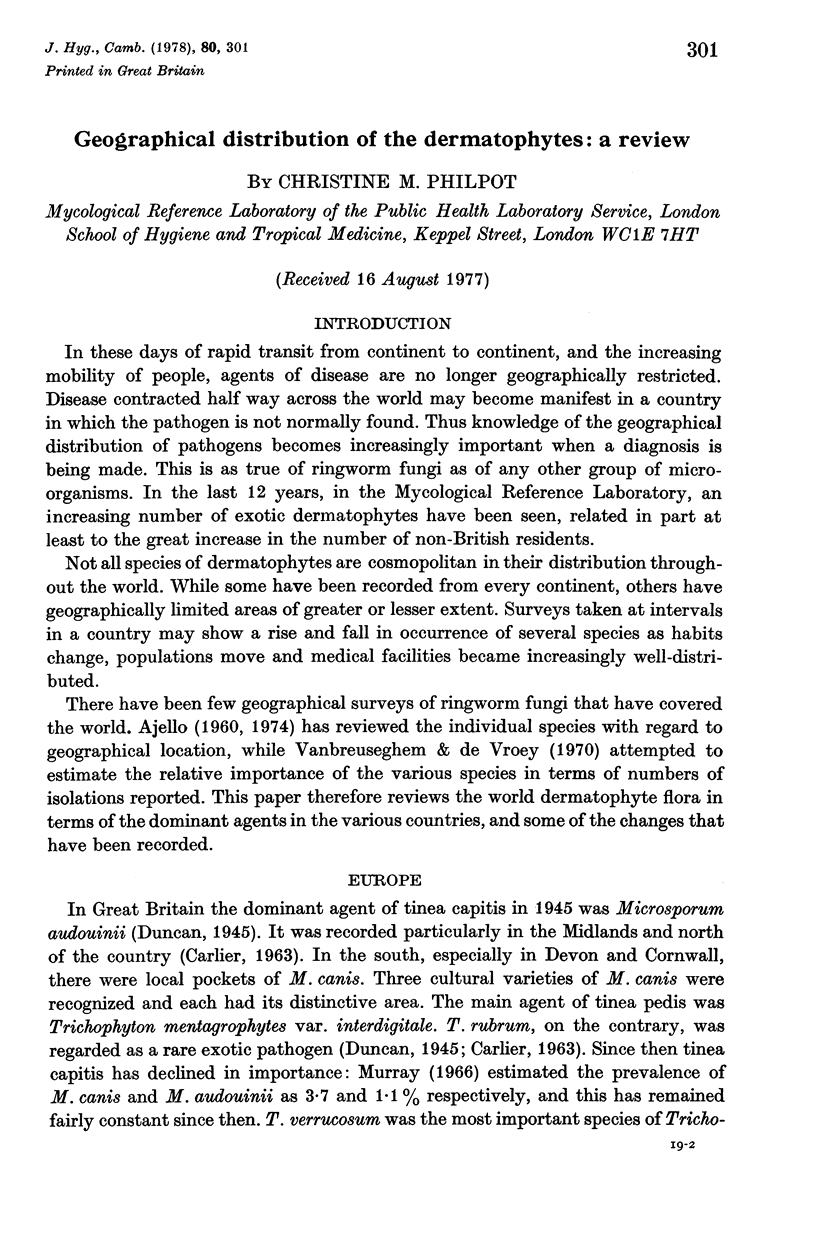
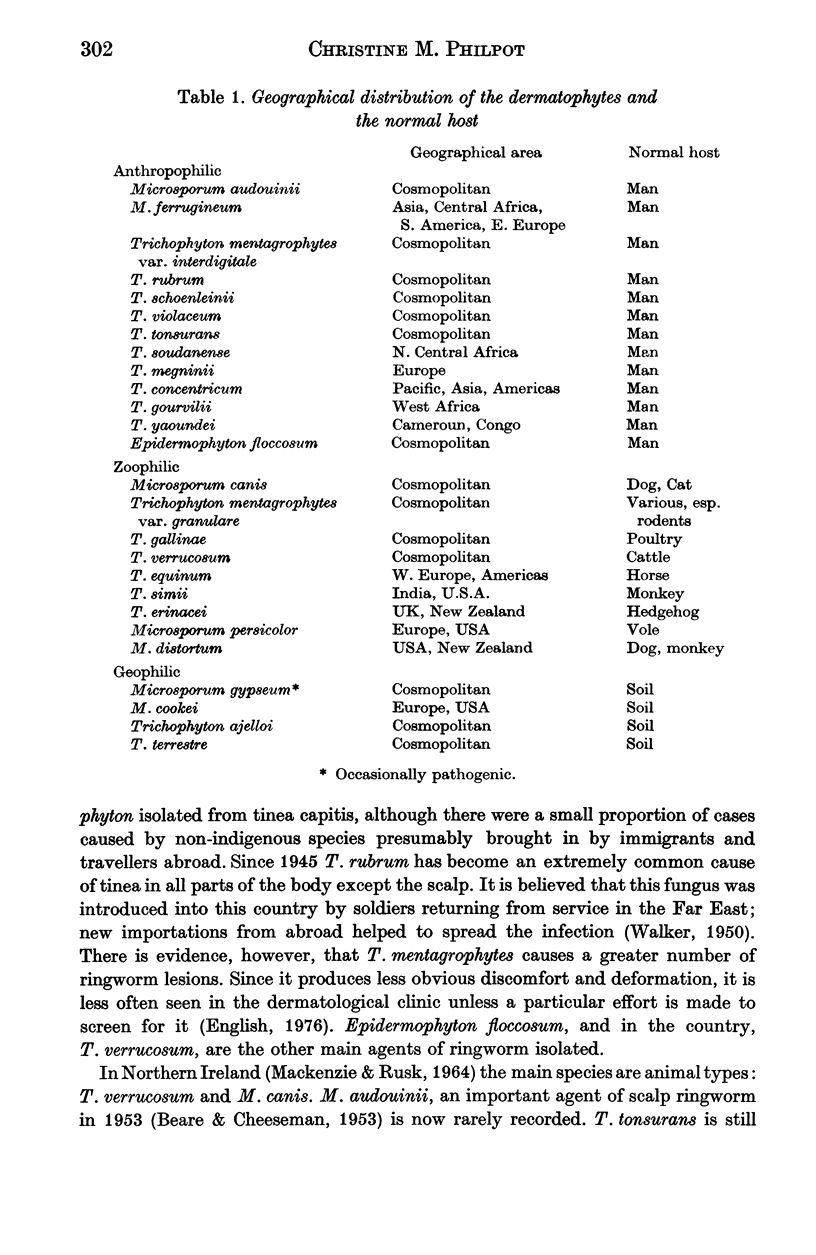
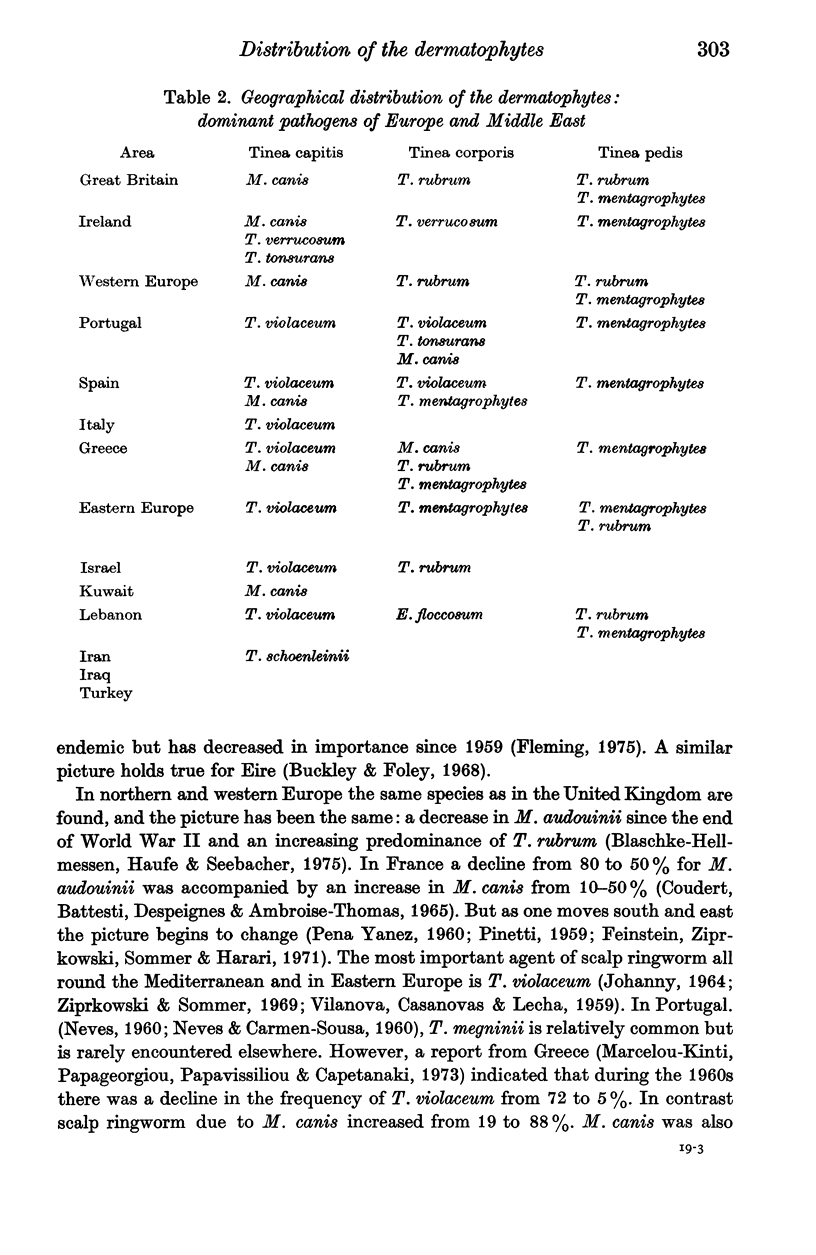
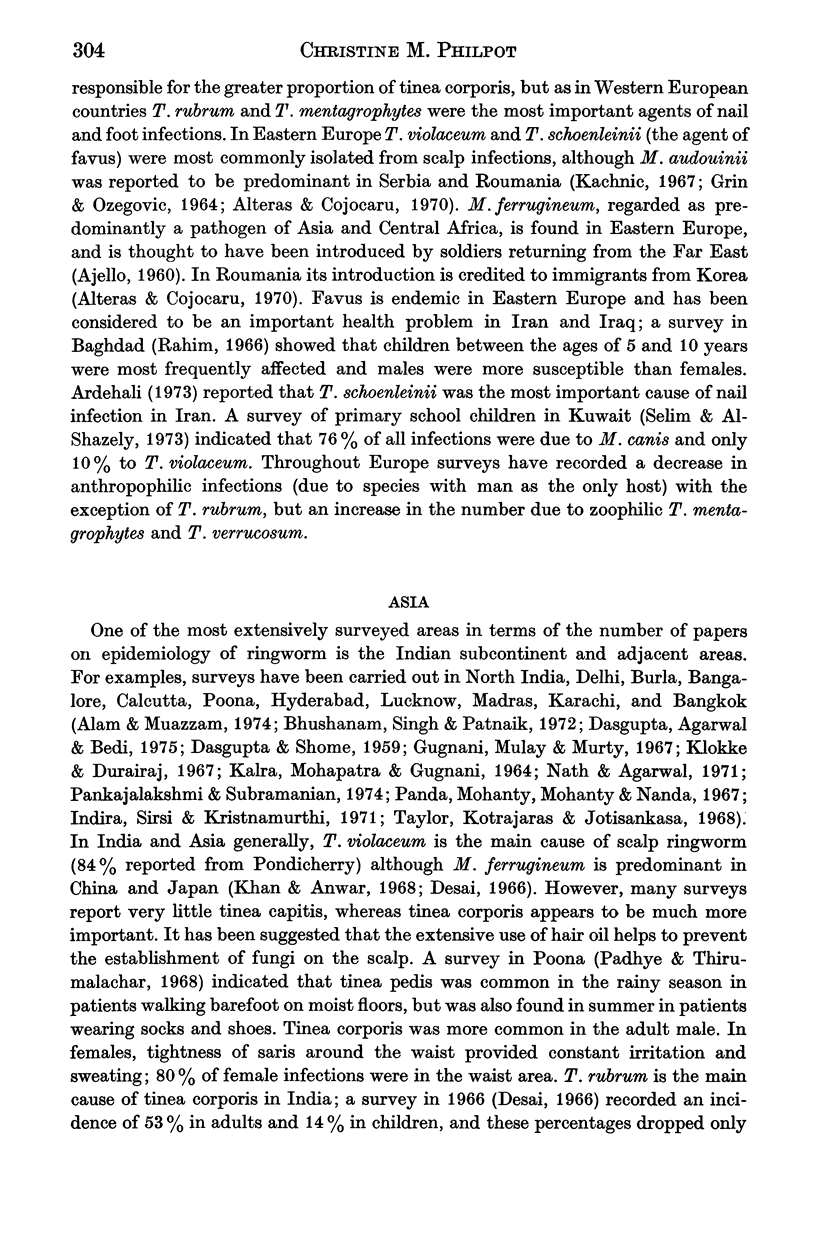
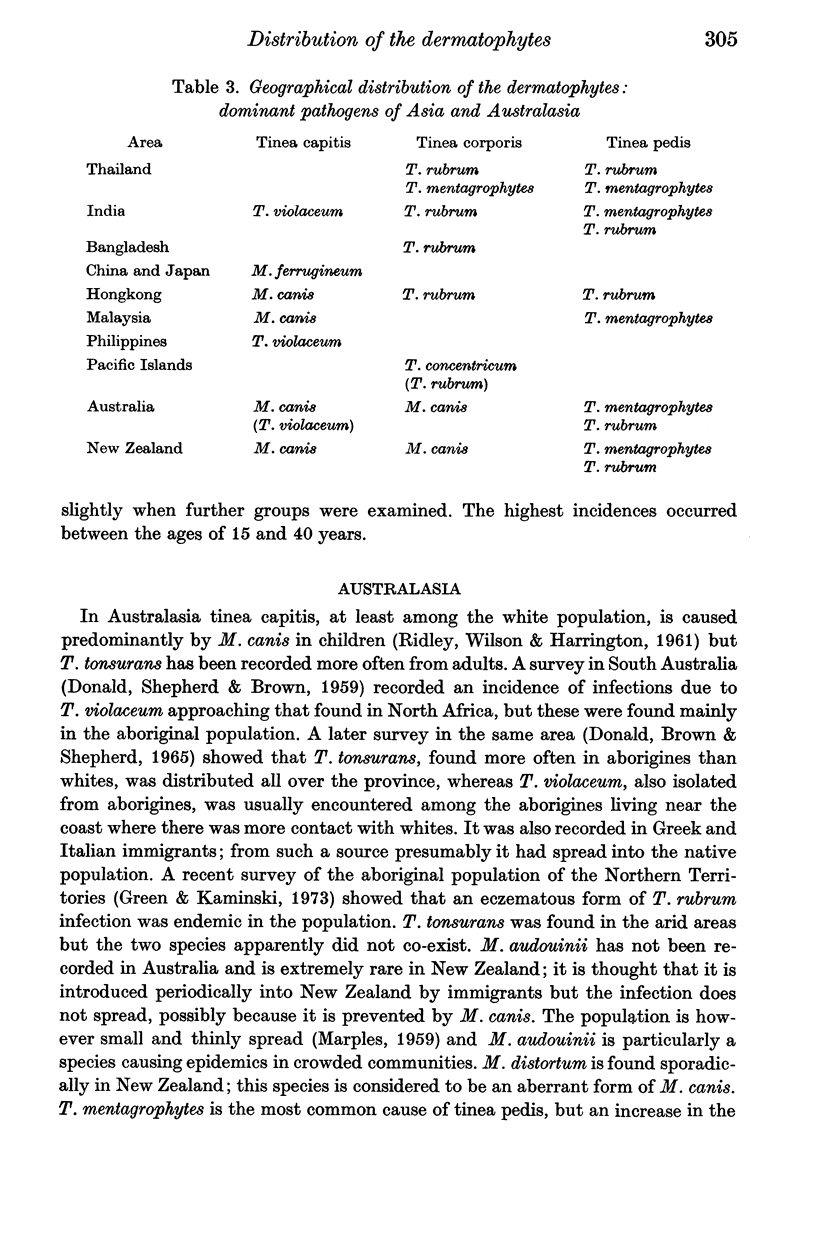
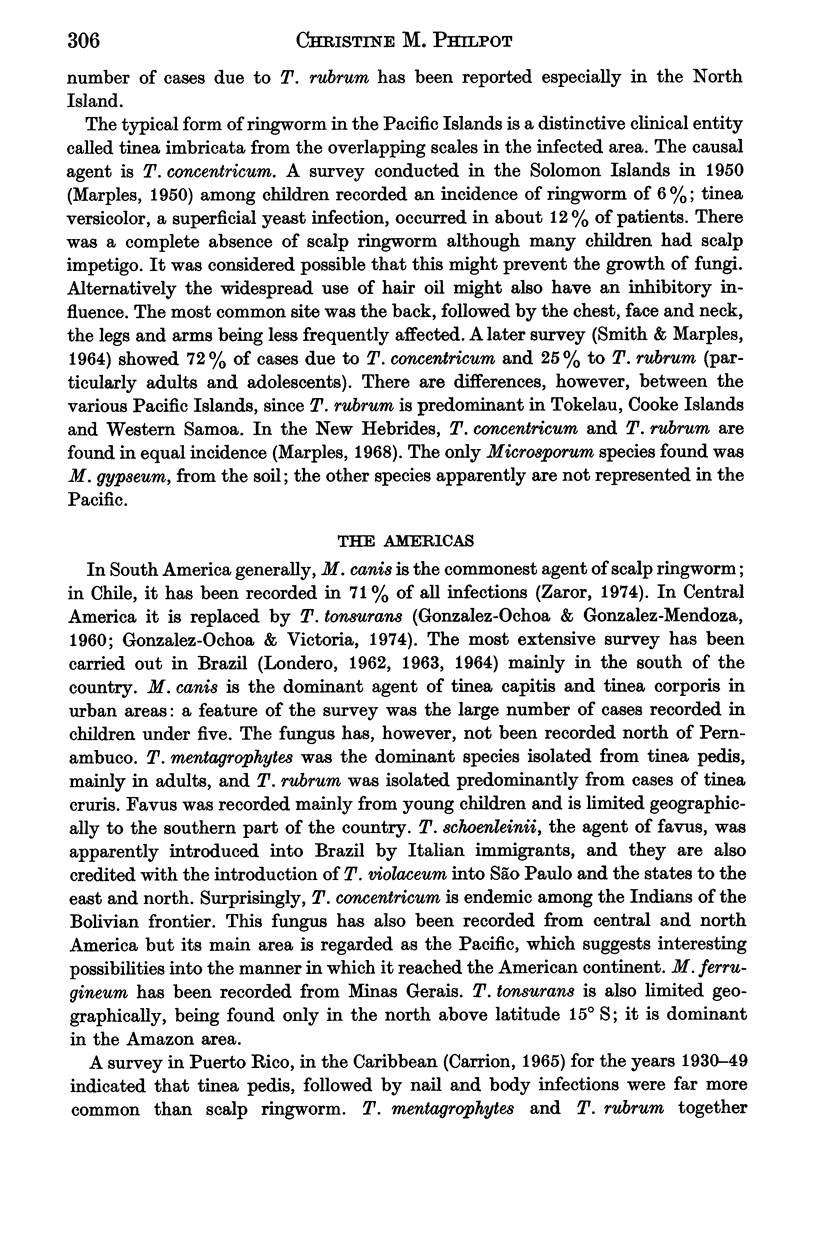
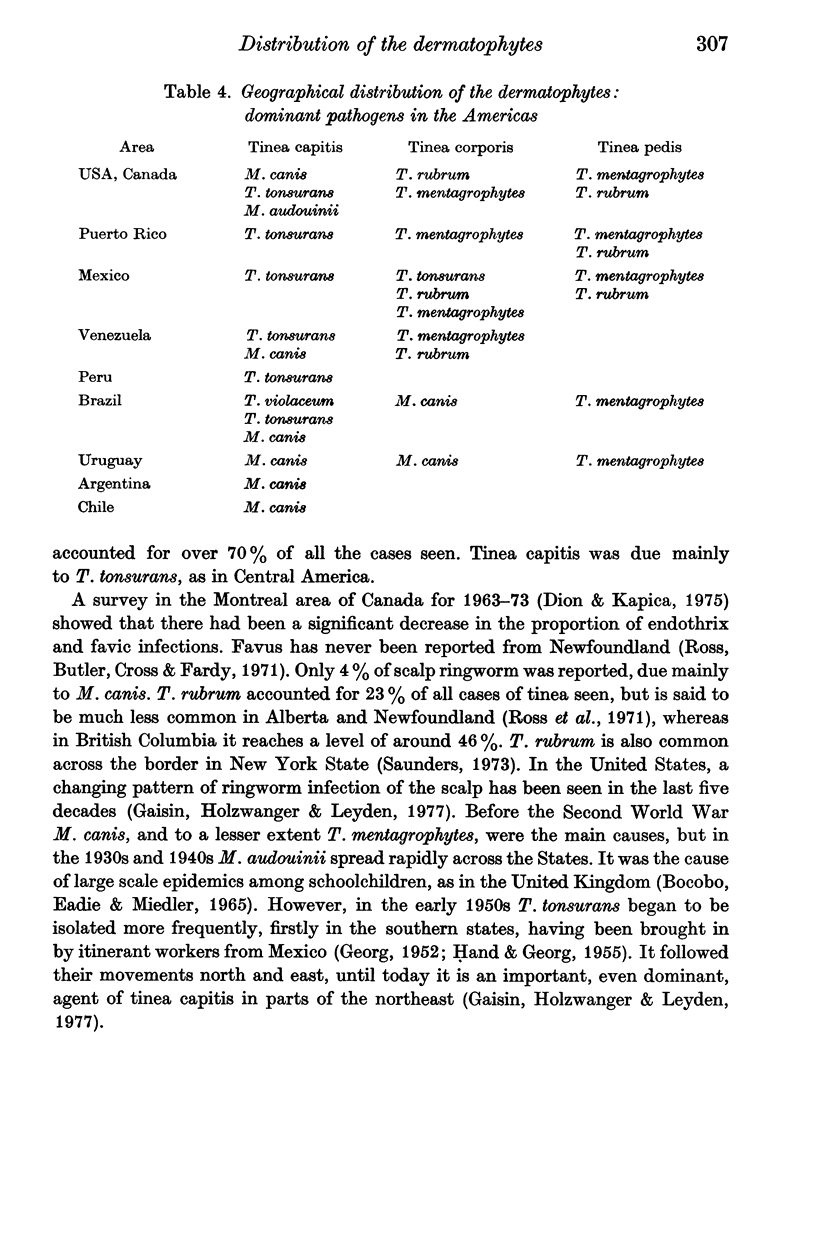
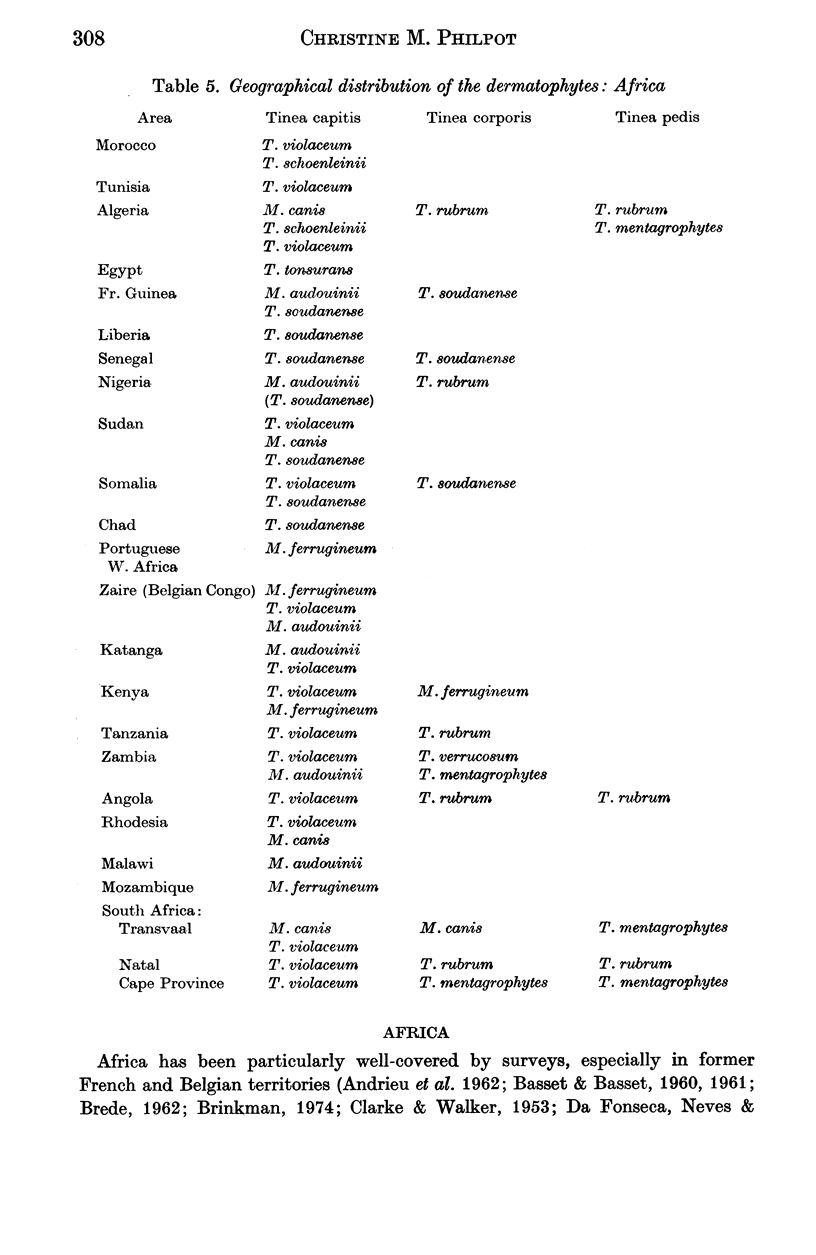
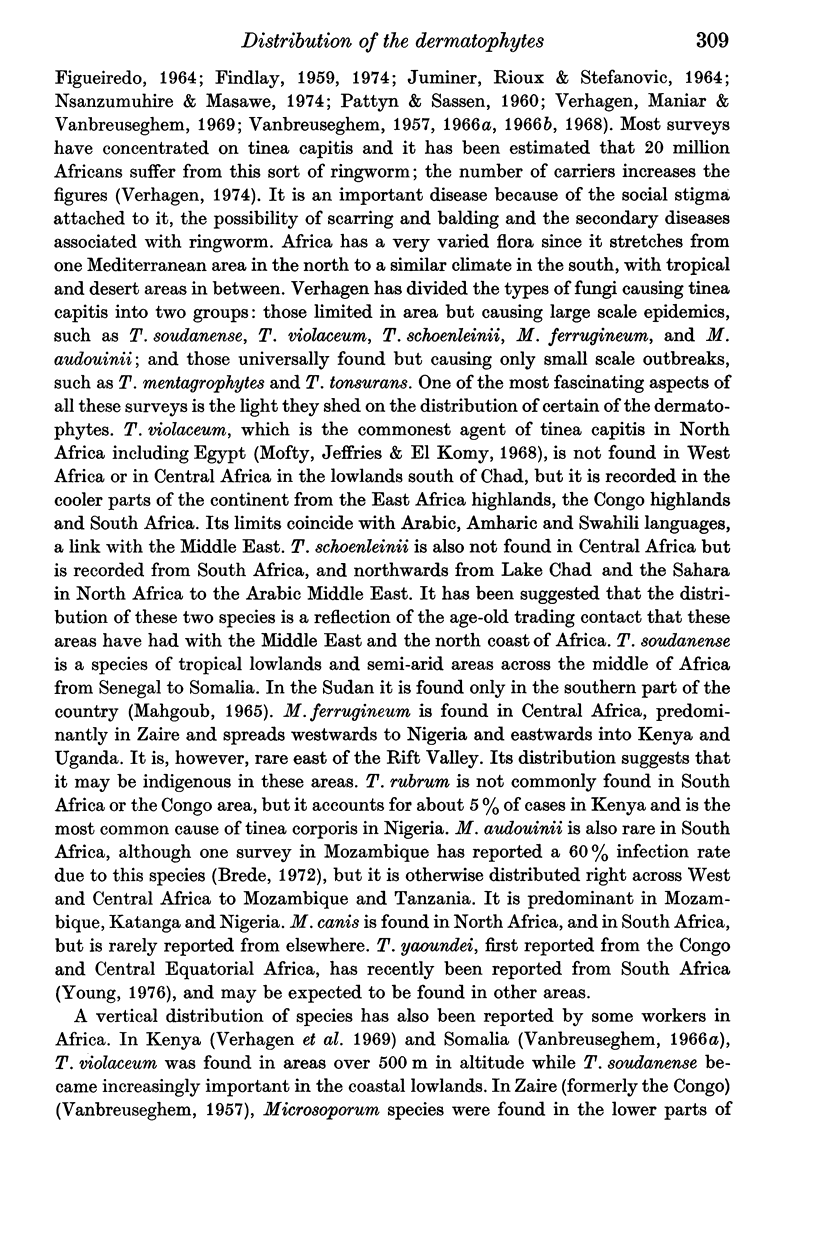
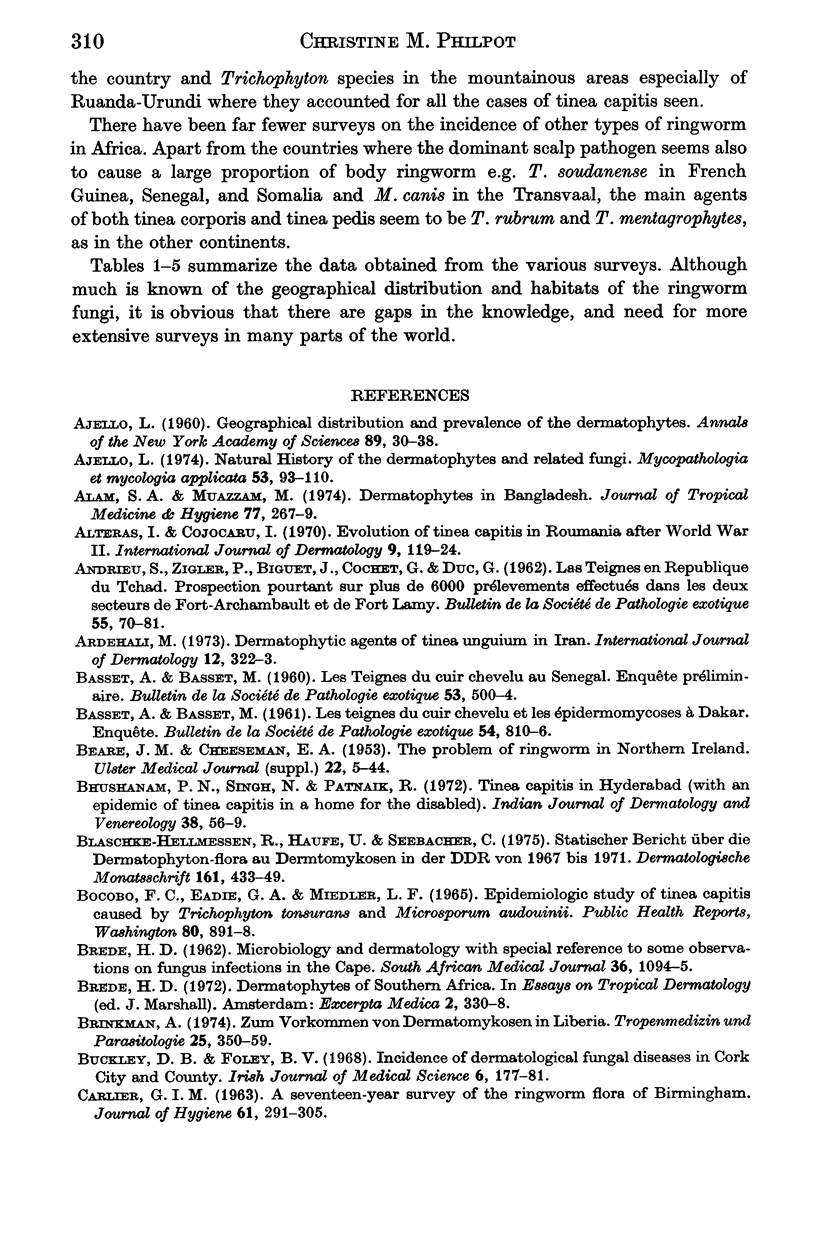
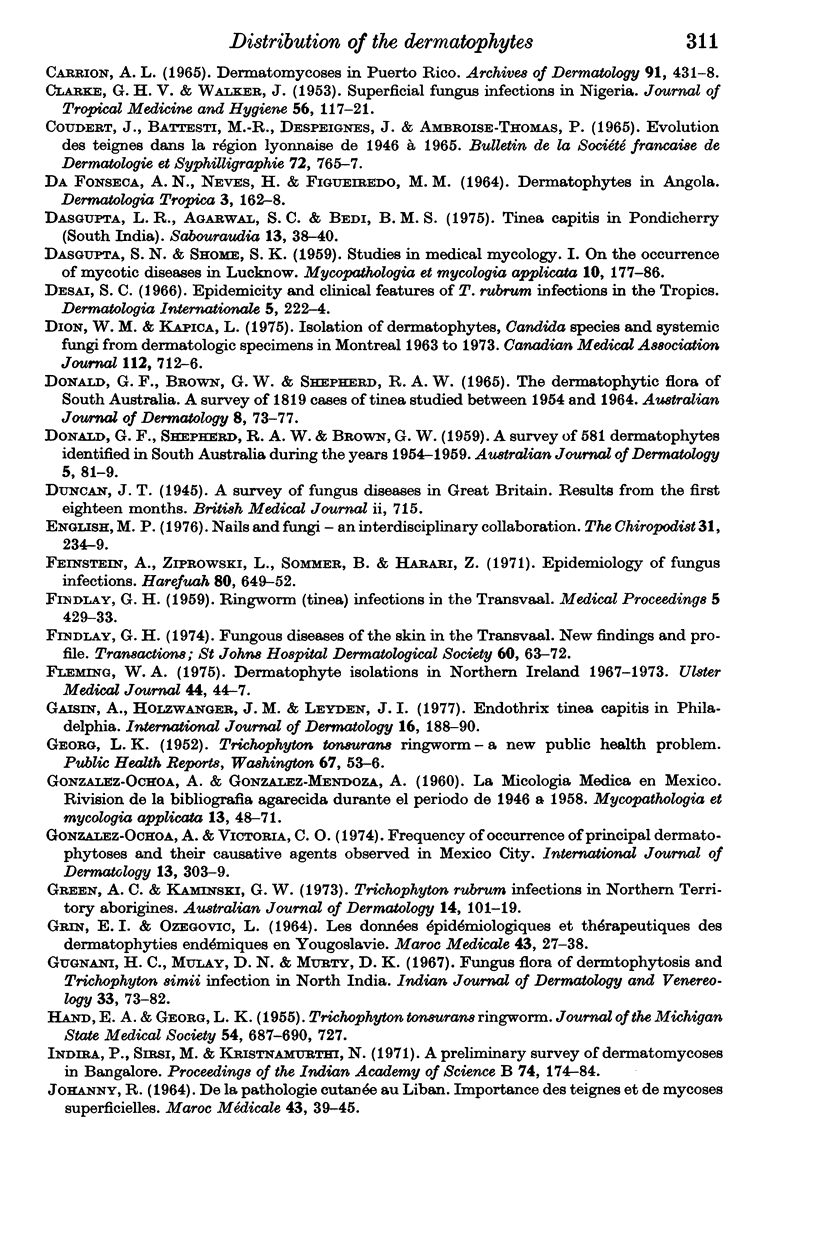
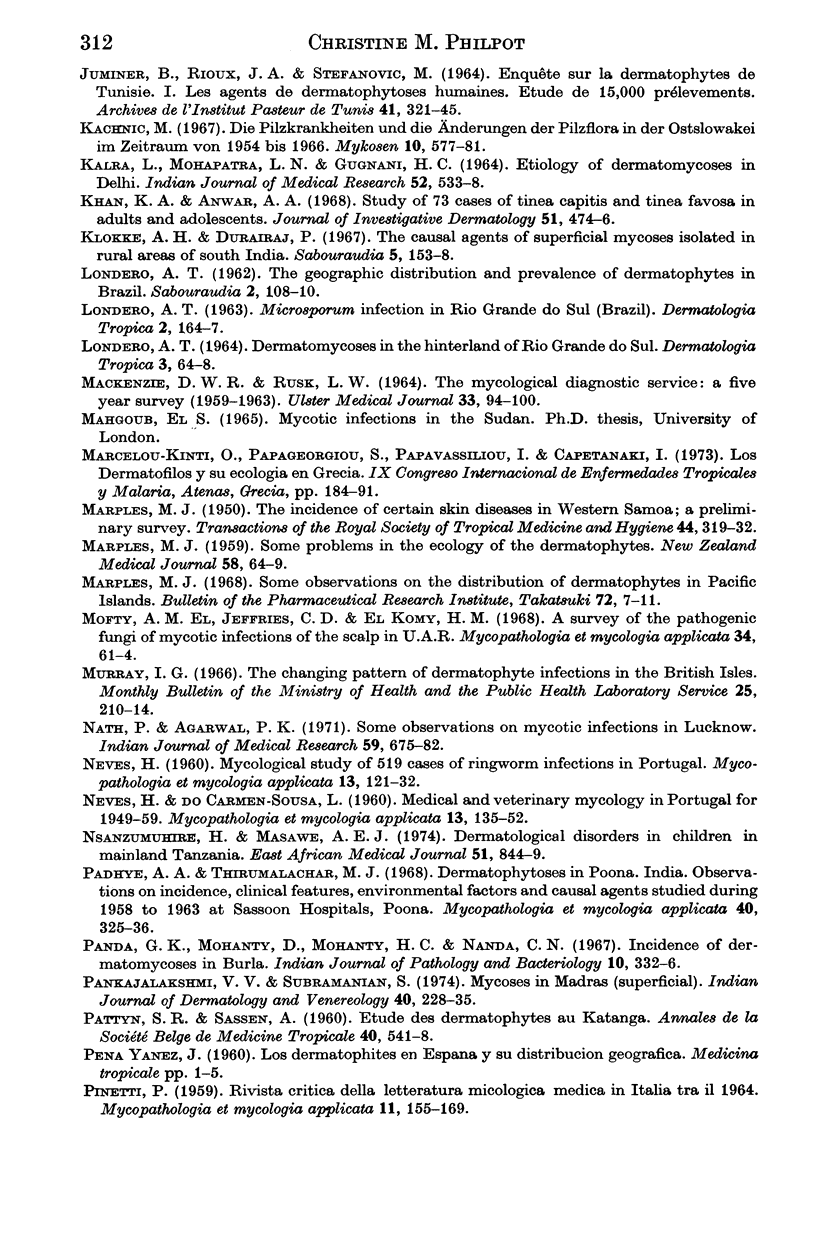
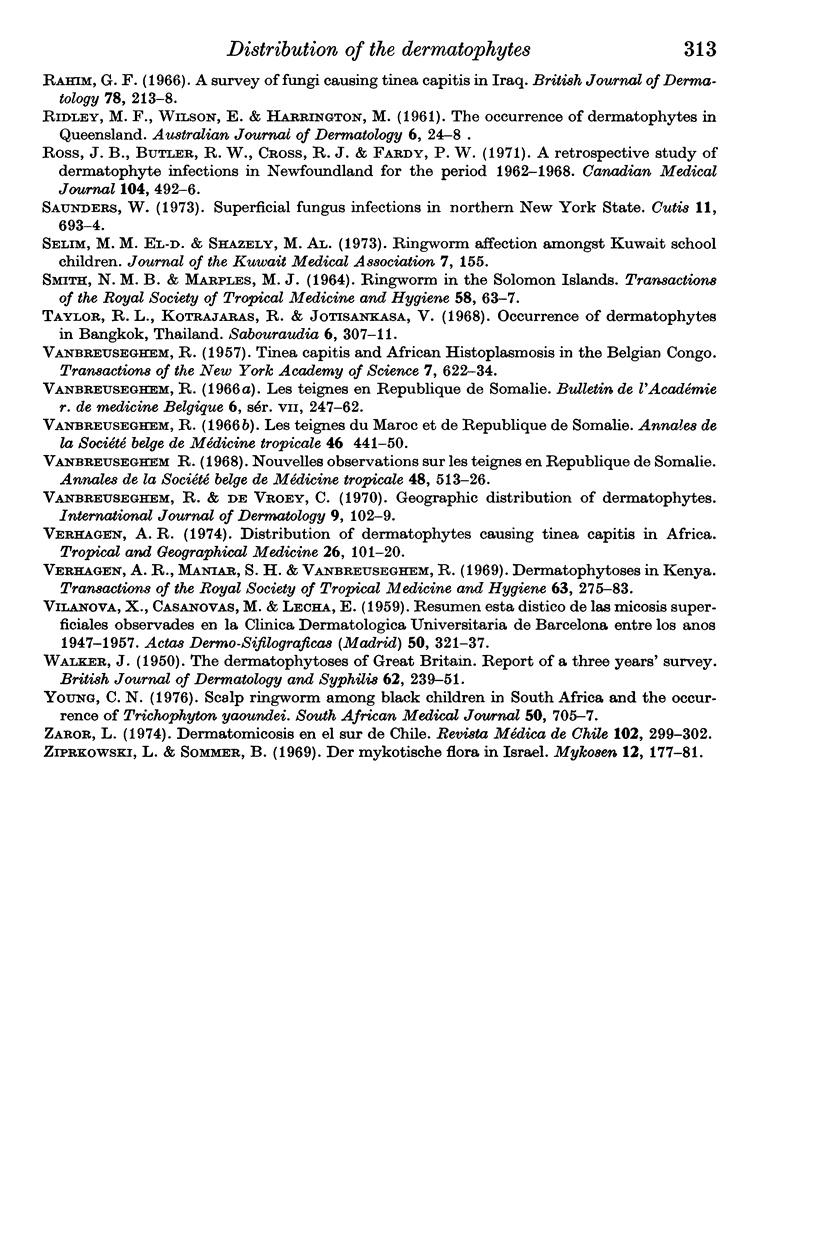
Selected References
These references are in PubMed. This may not be the complete list of references from this article.
- AJELLO L. Geographic distribution and prevalence of the dermatophytes. Ann N Y Acad Sci. 1960 Aug 27;89:30–38. doi: 10.1111/j.1749-6632.1960.tb20127.x. [DOI] [PubMed] [Google Scholar]
- Alam S. A., Muazzam M. G. Dermatophytes in Bangladesh. J Trop Med Hyg. 1974 Nov;77(11):267–269. [PubMed] [Google Scholar]
- Alteras I., Cojocaru I. Evolution of tinea capitis in Romania after World War II. Int J Dermatol. 1970 Apr-Jun;9(2):119–124. doi: 10.1111/j.1365-4362.1970.tb04590.x. [DOI] [PubMed] [Google Scholar]
- Ardehali M. Dermatophytic agents of tinea unguium in Iran. Int J Dermatol. 1973 Sep-Oct;12(5):322–323. doi: 10.1111/j.1365-4362.1973.tb00064.x. [DOI] [PubMed] [Google Scholar]
- BREDE H. D. Microbiology and dermatology, with special reference to some observations on fungus infections in the Cape. S Afr Med J. 1962 Dec 29;36:1094–1095. [PubMed] [Google Scholar]
- Blaschke-Hellmessen R., Haufe U., Seebacher C. Statistischer Bericht über die Dermatophytenflora bei Dermatomykosen in der DDR von 1967 bis 1971. Dermatol Monatsschr. 1975 Jun;161(6):433–449. [PubMed] [Google Scholar]
- Bocobo F. C., Eadie G. A., Miedler L. J. Epidemiologic study of Tinea capitis caused by T. tonsurans and M. audouinii. Public Health Rep. 1965 Oct;80(10):891–898. [PMC free article] [PubMed] [Google Scholar]
- CLARKE G. H., WALKER J. Superficial fungus infections in Nigeria. J Trop Med Hyg. 1953 May;56(5):117–121. [PubMed] [Google Scholar]
- DONALD G. F., SHEPPARD R. A., BROWN G. W. A survey of 581 dermatophytes identified in South Australia during the years 1954 to 1959. Aust J Dermatol. 1959 Dec;5:81–89. doi: 10.1111/j.1440-0960.1959.tb01572.x. [DOI] [PubMed] [Google Scholar]
- Dion W. M., Kapica L. Isolation of dermatophytes, Candida species and systemic fungi from dermatologic specimens in Montréal, 1963 to 1973. Can Med Assoc J. 1975 Mar 22;112(6):712–716. [PMC free article] [PubMed] [Google Scholar]
- Donald G. F., Brown G. W., Sheppard R. A. The dermatophytic flora of South Australia. A survey of 1819 cases of tinea studied between 1954 and 1964. Aust J Dermatol. 1965 Dec;8(2):73–77. doi: 10.1111/j.1440-0960.1965.tb01716.x. [DOI] [PubMed] [Google Scholar]
- Feinstein A., Ziprkowski L., Sommer B., Harari Z. [Epidemiology of fungus infections]. Harefuah. 1971 Jun 5;80(12):649–652. [PubMed] [Google Scholar]
- Findlay G. H. Fungous diseases of the skin in the Transvaal. New findings and profile. Trans St Johns Hosp Dermatol Soc. 1974;60(1):63–72. [PubMed] [Google Scholar]
- GONZALEZ-OCHOA A., GONZALEZ-MENDOZA A. [Medical mycology in Mexico. Review of the literature which appeared during the period 1946 to 1958]. Mycopathol Mycol Appl. 1960 Jun 30;13:48–71. doi: 10.1007/BF02107294. [DOI] [PubMed] [Google Scholar]
- GRIN E. I., OZEGOVIC L. LES DONN'EES 'EPID'EMIOLOGIQUES ET TH'ERAPEUTIQUES DES DERMATOPHYTIES END'EMIQUES EN YOUGOSLAVIE. Maroc Med. 1964 Jan;43:27–38. [PubMed] [Google Scholar]
- Gaisin A., Holzwanger J. M., Leyden J. J. Endothrix tinea capitis in Philadelphia. Int J Dermatol. 1977 Apr;16(3):188–190. doi: 10.1111/j.1365-4362.1977.tb01850.x. [DOI] [PubMed] [Google Scholar]
- HAND E. A., GEORG L. K. Trichophyton tonsurans ringworm. J Mich State Med Soc. 1955 Jun;54(6):687–passim. [PubMed] [Google Scholar]
- Kachnic M. Die Pilzkrankheiten und die Anderungen der Pilzflora in der Ostslowakei im Zeitraum von 1954 bis 1966. Mykosen. 1967 Dec 1;10(12):577–581. [PubMed] [Google Scholar]
- Khan K. A., Anwar A. A. Study of 73 cases of tinea capitis and tinea favosa in adults and adolescents. J Invest Dermatol. 1968 Dec;51(6):474–477. doi: 10.1038/jid.1968.157. [DOI] [PubMed] [Google Scholar]
- Klokke A. H., Durairaj P. The causal agents of superficial mycoses isolated in rural areas of South India. Sabouraudia. 1967 Feb;5(3):153–158. doi: 10.1080/00362176785190331. [DOI] [PubMed] [Google Scholar]
- LONDERO A. T. DERMATOMYCOSS IN THE HINTERLAND OF RIO GRANDE DO SUL (BRAZIL). Dermatol Trop Ecol Geogr. 1964 Jan-Mar;35:64–68. doi: 10.1111/j.1365-4362.1964.tb06019.x. [DOI] [PubMed] [Google Scholar]
- LONDERO A. T. MICROSPORUM INFECTION IN RIO GRANDE DO SUL (BRAZIL). Dermatol Trop Ecol Geogr. 1963 Jul-Sep;37:164–167. doi: 10.1111/j.1365-4362.1963.tb06142.x. [DOI] [PubMed] [Google Scholar]
- MARPLES M. J. Some problems in the ecology of the dermatophytes. N Z Med J. 1959 Feb;58(323):64–69. [PubMed] [Google Scholar]
- MARPLES M. J. The incidence of certain skin diseases in western Samoa: a preliminary survey. Trans R Soc Trop Med Hyg. 1950 Dec;44(3):319–332. doi: 10.1016/0035-9203(50)90060-5. [DOI] [PubMed] [Google Scholar]
- Mackenzie D. W. The mycological diagnostic service: a five-year survey (1959-1963). Ulster Med J. 1964 Dec;33(2):94–100. [PMC free article] [PubMed] [Google Scholar]
- Marples M. J. Some observations on the distribution of dermatophytes in Pacific Islands. Bull Pharm Res Inst. 1968 Jan;72:7–11. [PubMed] [Google Scholar]
- NEVES H. Mycological study of 519 cases of ringworm infections in Portugal. Significance of multiple localizations. Tinea as a single infection. Mycopathol Mycol Appl. 1960 Jul 30;13:121–132. doi: 10.1007/BF02155509. [DOI] [PubMed] [Google Scholar]
- NEVES H., do CARMO-SOUSA Medical and veterinary mycology in Portugal for 1949-1959. Mycopathol Mycol Appl. 1960 Jul 30;13:135–152. doi: 10.1007/BF02155511. [DOI] [PubMed] [Google Scholar]
- Nath P., Agarwal P. K. Some observations on mycotic infections in Lucknow. Indian J Med Res. 1971 May;59(5):675–682. [PubMed] [Google Scholar]
- Nsanzumuhire H., Masawe A. E. Dermatological disorders in children in mainland Tanzania. East Afr Med J. 1974 Dec;51(12):844–849. [PubMed] [Google Scholar]
- PINETTI P. [Analytic review of the medical mycology literature in Italy between 1946 and 1956]. Mycopathol Mycol Appl. 1959 Sep 15;11:155–169. doi: 10.1007/BF02051616. [DOI] [PubMed] [Google Scholar]
- Padhye A. A., Thirumalachar M. J., Gokhale B. B. Dermatophytoses in Poona, India. Observations on incidence, clinical features, environmental factors and causal agents studied during 1958 to 1963 at sassoon hospitals, Poona. Mycopathol Mycol Appl. 1970 Aug 31;40(3):325–336. doi: 10.1007/BF02051785. [DOI] [PubMed] [Google Scholar]
- Panda G. K., Mohanty D., Mohanty H. C., Nanda C. N. Incidence of dermatomycosis in Burla. Indian J Pathol Bacteriol. 1967 Oct;10(4):332–336. [PubMed] [Google Scholar]
- RIDLEY M. F., WILSON E., HARRINGTON M. The occurrence of dermatophytes in Queensland. Aust J Dermatol. 1961 Jun;6:24–28. doi: 10.1111/j.1440-0960.1961.tb01324.x. [DOI] [PubMed] [Google Scholar]
- Ross J. B., Butler R. W., Cross R. J., Fardy P. W. A retrospective study of dermatophyte infection in Newfoundland for the period 1962-1968. Can Med Assoc J. 1971 Mar 20;104(6):492–496. [PMC free article] [PubMed] [Google Scholar]
- SMITH J. M., MARPLES M. J. RINGWORM IN THE SOLOMON ISLANDS. Trans R Soc Trop Med Hyg. 1964 Jan;58:63–67. doi: 10.1016/0035-9203(64)90070-7. [DOI] [PubMed] [Google Scholar]
- Taylor R. L., Kotrajaras R., Jotisankasa V. Occurrence of dermatophytes in Bangkok, Thialand. Sabouraudia. 1968 Oct;6(4):307–311. doi: 10.1080/00362176885190601. [DOI] [PubMed] [Google Scholar]
- Vanbreuseghem R., De Vroey C. Geographic distribution of dermatophytes. Int J Dermatol. 1970 Apr-Jun;9(2):102–109. doi: 10.1111/j.1365-4362.1970.tb04587.x. [DOI] [PubMed] [Google Scholar]
- Verhagen A. R. Distribution of dermatophytes causing tinea capitis in Africa. Trop Geogr Med. 1974 Jun;26(2):101–120. [PubMed] [Google Scholar]
- Verhagen A. R., Maniar S. H., Vanbreuseghem R. Dermatophytoses in Kenya. Trans R Soc Trop Med Hyg. 1969;63(2):275–283. doi: 10.1016/0035-9203(69)90159-x. [DOI] [PubMed] [Google Scholar]
- Young C. N. Scalp ringworm among Black children in South Africa and the occurrence of Trichophyton yaoundei. S Afr Med J. 1976 Apr 24;50(18):705–707. [PubMed] [Google Scholar]
- Zaror L. Dermatomicosis en el sur de Chile. Rev Med Chil. 1974 Apr;102(4):299–302. [PubMed] [Google Scholar]
- Ziprkowski L., Sommer B. Die mykotische Flora in Israel. Mykosen. 1969 Mar 1;12(3):177–181. [PubMed] [Google Scholar]


